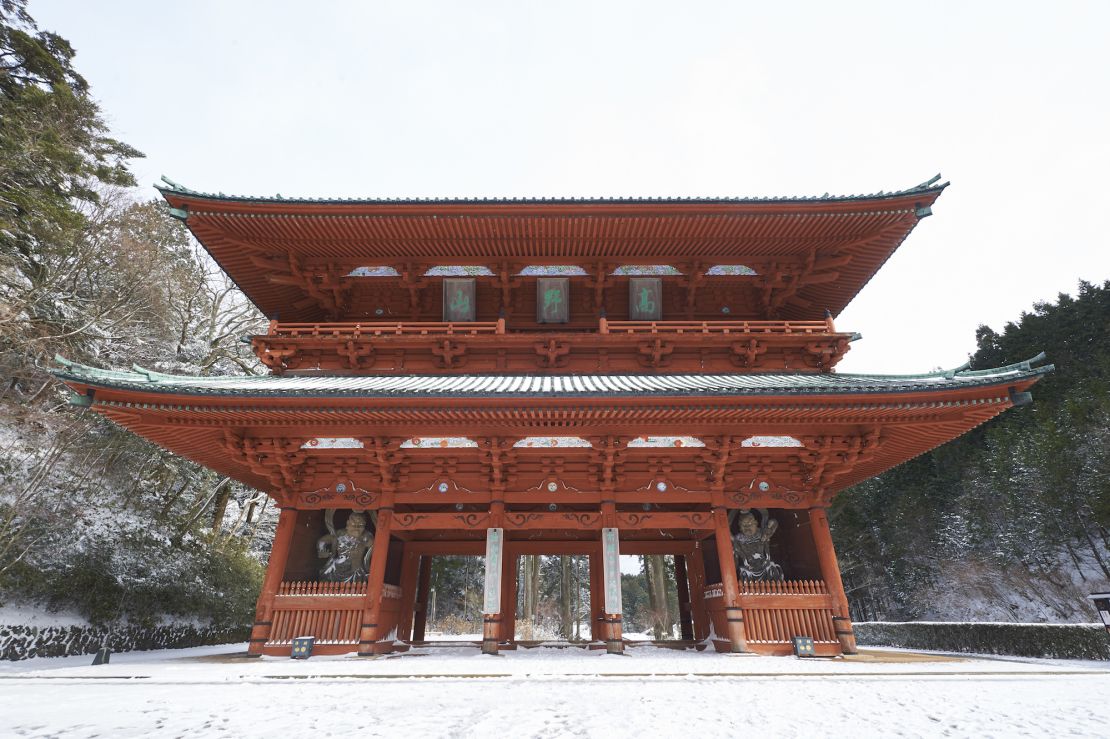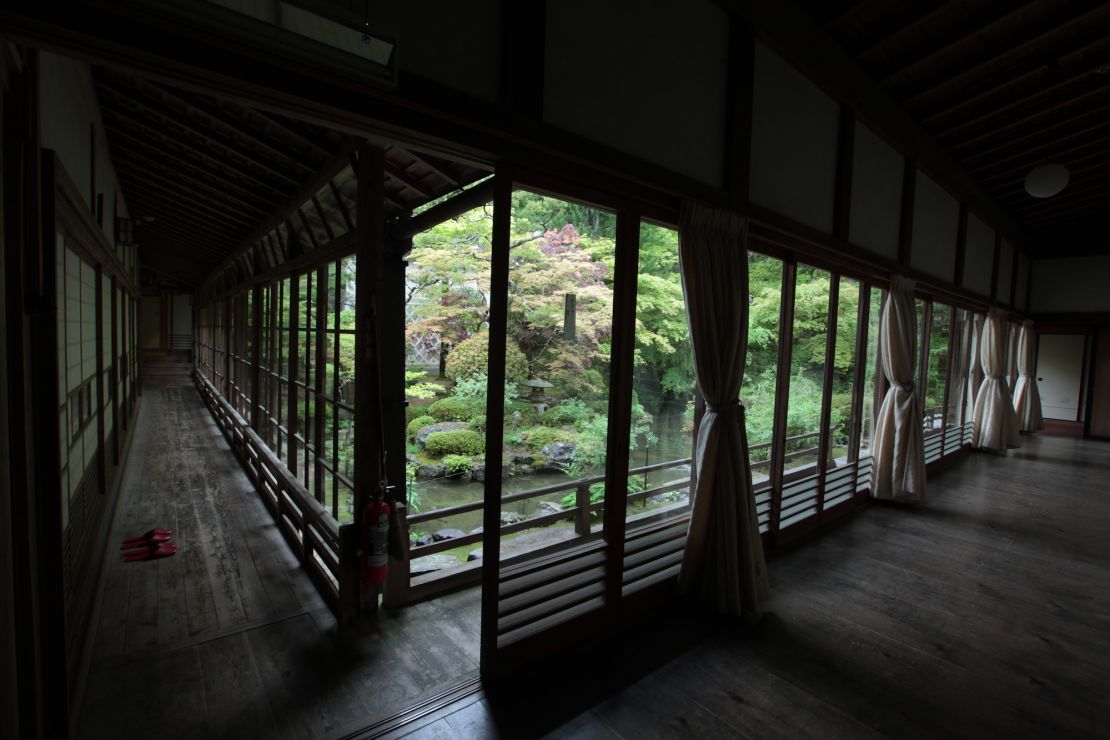Story highlights
Koyasan is the headquarters of Shingon Buddhism, a Chinese-influenced esoteric sect
Women were banned from Koyasan until 1872
The 'women pilgrims route' allowed them to get close -- but not too close -- to the temple complex
It’s difficult to imagine how the female pilgrims trekking the perimeter of Koyasan, one of the most holy sites in Japan, must have felt while making their journey centuries ago.
On the one hand, this “women pilgrims route” in Wakayama prefecture is 17-kilometer stretch of incredible natural beauty.
Thick, silent forests, moss-covered rocks and trickling streams share space with historic shrines, crumbling deities and red torii gates. Occasionally, the densely forested trail breaks free from its covered confines to reveal open skies and the dramatic vistas of Japan’s mountainous Kii Peninsula.
On the other hand, the trail symbolizes their forbidden status – a path forged to allow female pilgrims a chance to make offerings and feel the spiritual energy of the mountaintop temple complex without actually entering because of Koyasan’s ban on female visitors.
Surely it must have stung just a little to be so close to this holy site, made worse by the fleeting glimpses of Koyasan’s religious architecture that appear to those walking the trail, yet still unable to enter.
Overnight on one of the world’s most sacred mountains
Unlike the trail’s beauty, times have changed
Fortunately, women are no longer personae non gratae there.
Founded in 806 by a man named Kobo Daishi, one of Japan’s most revered religious figures, Koyasan is the headquarters of Shingon Buddhism, a Chinese-influenced esoteric sect.
In 1872, the incoming Meiji government declared that Buddhist monks should be free to take wives and have children. Around this time, the ban on female visitors ended. But that doesn’t mean it’s not worth retracing the steps of the once forbidden pilgrims – regardless of whether you’re a man or woman.

The route takes about six to seven hours to hike, though it can be broken into even smaller treks. It passes all seven of Koyasan’s traditional entrances. And it’s quiet. During our visit, we encountered fewer than 10 other hikers.
We opted for a shorter journey, which took about three hours and began on the outskirts of Koyasan at Fudozaka-guchi Nyonindo, the only one of seven “women’s halls” built to accommodate female pilgrims still standing.
Passing the sacred Daimon Gate, our hike ended near the entrance of Okunoin, home to the mausoleum of Kobo Daishi and what must be one of the world’s most beautiful cemeteries. Its cobblestone trail, lined with ancient cedar tress, is filled with more than 200,000 gravestones and memorials.
A map of the women pilgrims route can be downloaded on Koyasan’s official website.
Koyasan, Japan: Staying with monks on one the world's most sacred mountains
Overnight in Koyasan
World’s best unknown hike – Japan’s Kumano Kodo
After the hike it’s worth spending at least a full day exploring Koyasan. With a population of about 3,000 people, the town has ancient forests, historic pagodas, paved roads, restaurants, schools, cafes and souvenir shops.
In addition to Okunoin, another popular attraction is Danjo Garan, often described as the second-most sacred site in Koyasan. It’s made up of 20 religious structures, from pagodas to torii gates and temples.
There’s also Banryutei, Japan’s largest rock garden. Located in the inner courtyard of Koyasan’s Kongobuji temple, it was completed in 1984 to commemorate the 1,150th anniversary of Kobo Daishi’s ascent into eternal meditation.
Of Koyasan’s 117 temples, there are more than 50 that allow overnight guests. Though temple stays usually evoke images of excessive minimalism and hard floors, the ones here prove a spiritual experience doesn’t have to be uncomfortable.
Koyasan’s temples vary in terms of amenities and prices but there are a few common denominators. Most of the traditional Japanese guest rooms have their own washroom, but you will need to use the public baths.
Guests sleep on comfortable futons, which are rolled out at night onto the rooms’ tatami floors. Facilities include gardens, a tea ceremony room, prayer hall and library.

In addition to morning prayers, guest activities at some temples include “sutra copying” (transcription of 262 words of Hanya Shinkyo scripture) and meditation sessions.
All temple meals are shojin ryori (vegan Buddhist cuisine) though for those craving a bit of meat or sushi there are more diverse offerings at Koyasan’s regular restaurants. We had a chance to check out four different temples that are equipped to service foreign tourists, all of which offer comfortable, clean rooms, beautiful gardens and courteous staff.
These are: Henjoko-in Temple (35 guest rooms), Shojoshin-in Temple (30 guest rooms), Rengejo-in Temple (48 guest rooms) and Fudou-in Temple (22 guest rooms).
All of these can all be booked on the official Koyasan website.
Sagano Bamboo Forest – one of world’s most beautiful groves
Getting there
The Nankai Electric Railway makes four round-trips a day by Limited Express and runs Express trains at about 30-minute intervals between Osaka Namba Station and Koyasan Station.
The trip takes 100 minutes by Limited Express, and about two hours by Express. From Koyasan Station, visitors can hop on a 10-minute bus to Koya town.
























